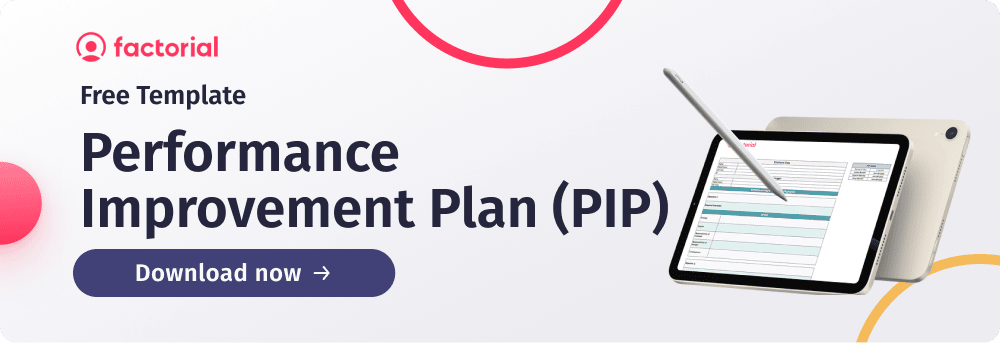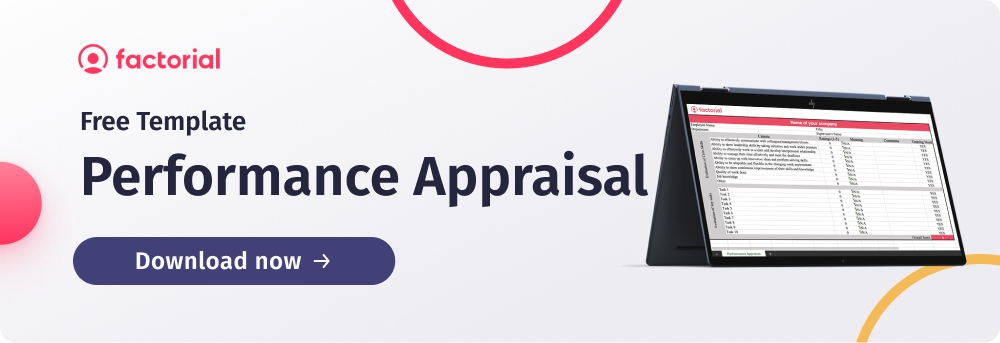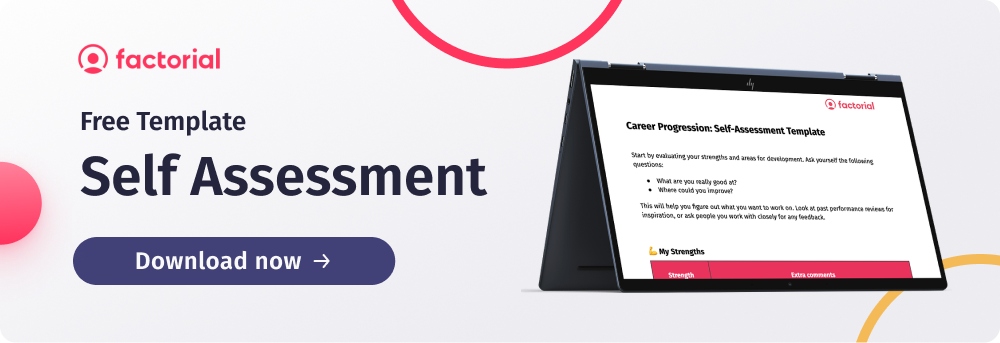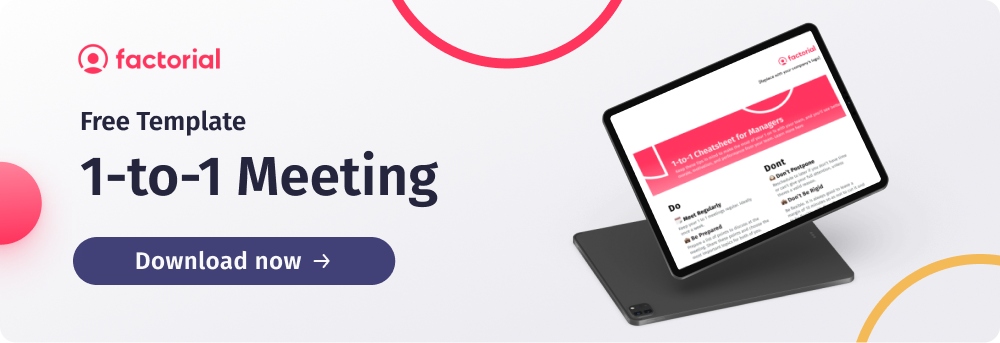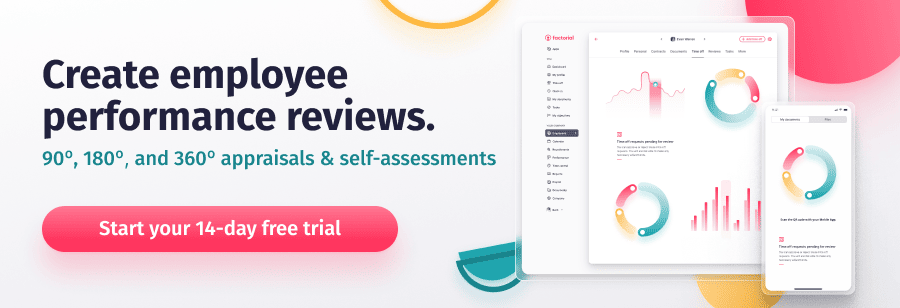In our latest Fireside Chat, Paola Tartaglione, Head of HR and People at TaxScouts, and Anna-May Jones, Account Manager at Factorial, shared their inside knowledge on managing employee performance and the benefits a company can get by implementing various reviews and meetings. Here you can read a short summary of the main concepts and questions they discussed.
The Benefits of Employee Performance Management
Why is performance management important?
Performance management is one of the most important areas of the employee life cycle. We spend a lot of time and effort to attract, recruit and hire great candidates. It is important not to stop there but keep offering an exceptional “people experience” to all our employees.
When properly conducted, employee performance management is vital to an organisation’s success for different reasons:
People are the greatest assets of an organisation, so effectively managing employee performance is critical. After Covid19, which brought many changes to the workplace, employees want more than just great pay and benefits. They want their employers to prioritise their well-being, provide greater transparency around career development, and do work that has purpose and impact.
Hence why it is essential that employees understand what’s expected from them, what is their place within the company, the effect of their role and how they contribute to the business goals and results. In this way, they feel motivated, engaged and productive, with a mission to accomplish!
At the same time, employees want a career, not a job that views their skills as a transactional process; most employees do actually appreciate feedback on their work and they definitely want to know what they can do to grow.
In this scenario, managing employee performance is a great tool to motivate workers with the strategic development of their skills – because with feedback conversation we can provide our employees support, offer training and development and deliver reward and recognition.
The workforce is changing and so are their expectations; People expect a more individualised work experience. In this context, the essence of managing performance is to help people grow; frequent feedback also helps managers spot and address issues as they arise and act proactively.
How does performance management help an organisation?
Employee performance management definitely helps a company build a high-performance culture (a set of behaviours, values and norms that lead an organisation to achieve business goals). Performance management provides employees with the space to be who they are and the support to become who they want to be. In my opinion, high performance and growth conversations need to become a part of every company’s DNA. – Paola Tartaglione, TaxScouts
What other benefits does performance management have?
- Performance management creates clarity around goals – must be clear what goals they are trying to achieve, and how successful they are in reaching or not them.
- Allows for the exchange of feedback – Employees want feedback and they want it regularly. They need (and deserve) to know how they are performing and how they can improve. It’s called two-way feedback. All this leads to:
- Encourage employee reward and recognition
- Boost employee engagement and productivity
- Create employee development opportunities
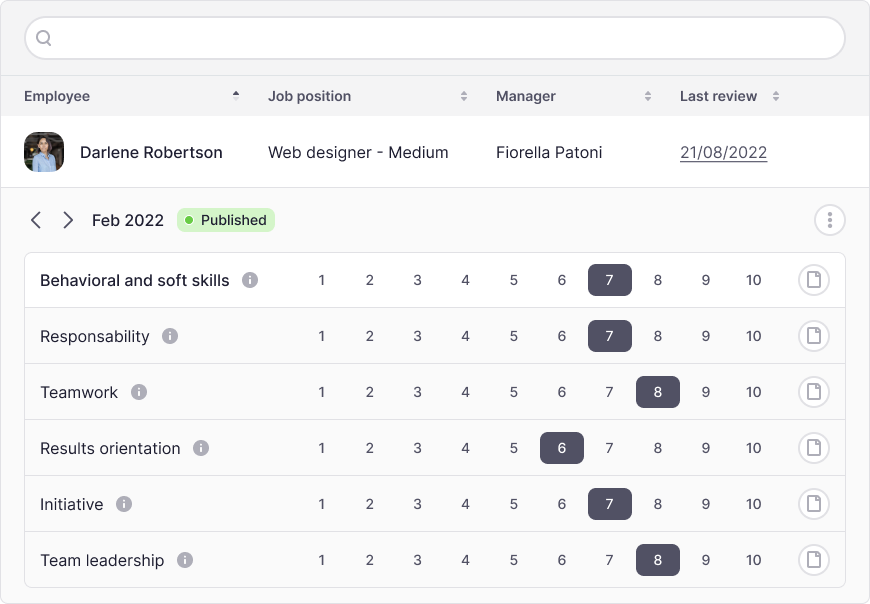
Performance Review
What is a performance review?
A process where managers assess the team members’ performance and discuss this with them. Performance reviews are a great opportunity to also support professional growth, learning and development.
I do believe that managing employee performance reviews should be an ongoing process and not something that is limited to the annual performance review – instead, ongoing conversations year round which gives clarity to the employees about what they need to be successful in their roles and support their career growth. When honest feedback is given regularly, performance conversations can be centred around development instead of only feedback. – Paola Tartaglione, TaxScouts
How to ace a performance review
Regular feedback boosts motivation. It’s vital that employees can contribute or respond to the feedback they receive. For that reason, if you want to ace a performance review, you need to focus on the following aspects:
- Less focus on annual appraisals, and more focus on regular performance reviews
We do this through development check ins which are conversations between managers and employees, reserved for personal and professional matters; these are owned by the individual, not their manager. It’s their space to discuss their progress and any personal topics. A few days before we send a few questions to the team member and manager via Factorial. – Paola Tartaglione, TaxScouts
- Focus on high-quality conversations, often using a coaching/mentoring style
- Less focus on judging past performance; a greater focus on understanding current challenges and opportunities to help people improve
- Provide structure to create a consistent experience
We use Factorial to keep to keep track of their performance and progress, gather feedback, and reflect on career goals. – Paola Tartaglione, TaxScouts
- Ensure two-way discussion – giving feedback requires people skills:
- Ask good questions – ask people to expand on their experiences, views and feelings
- Active listening
- Giving constructive feedback
- Focus not just on the past but also on the future: people want to know what they need to do to grow in the future; recently I’ve read something interesting: “don’t review, give a preview!”
How to conduct a performance review
First of all, ensuring managers are able to have great conversations around managing performance. If needed, coach, train, and develop them. Then we have clarity. Make sure employees’ expectations are clear, share feedback, and discuss development needs to boost their performance. And last, but not least, we need to pay attention to providing regular feedback. Make sure you build a culture of continuous feedback.
As said before, performance management is not just about evaluating if the team member has performed the role according to the expectations or if they have executed the tasks; it’s about creating an environment where employees feel valued, recognised and motivated. And all this leads to better employee engagement.
Self-Evaluation
What is self-evaluation?
Self-evaluation is a process where you observe, analyse and potentially improve your own performance, contribution, actions and results. Basically, the goal of self-evaluation is to provide honest insights into how you perceive your performance and reflect on how others may perceive it as well.
How to complete a self-evaluation
Think of your top accomplishments such as goals achieved, and successful projects. A great way is to collect analytics for example to show impact (i.e. using data in your self-evaluation will show your contribution and your results). At the same time, think about areas you need to improve on or situations you have handled poorly – discuss this with your manager and ask for guidance for making improvements. Tip: when identifying weaknesses, frame them as opportunities and create a plan of action.
When completing a self-evaluation, I usually think of three main areas I ideally want to focus on: Start, stop, continue! – Paola Tartaglione, TaxScouts
- What to start doing – What are you not doing now that you should be doing?
- What to stop doing – What are you doing that did not work out as expected? Which things could be done differently?
- What to keep doing – What have you done that has contributed to your accomplishments? How have you developed strong working relationships?
When completing a self-evaluation, ask yourself the following questions:
- Where have I excelled?
- What achievements am I most proud of?
- Where do I feel I need more support?
- What goals do I wish I could have achieved? How could I have done better? What would help me to reach those goals?
- Which are the goals I hope to achieve next month/quarter etc?
What are the benefits of self-evaluation?
The self-evaluation is an important part of performance review, everyone should do it because it reflects their self-awareness. When you are self-aware, you are conscious of your strengths and weaknesses—and how others perceive you.
Being self-aware not only benefits you on an individual level, but it also helps your company.
On an individual level, you feel more engaged in the performance review process, you feel more confident about your skills and abilities, and you become more accountable and feel more valued and motivated to learn new skills. It also helps you and your manager to select training programs that might be suitable for your needs.
On the company level, when your teams feel heard through the self-evaluation process, they are more likely to listen to feedback from their managers. Managers are able to gain insights into how employees feel about their work, and their team and a real sense of how employees view their jobs.
Self-assessment and continuous feedback contribute widely to a culture of trust and engagement.
360-Degree Feedback
How to create and conduct a 360-degree feedback form?
360-degree reviews incorporate feedback from an individual’s team members, direct reports, cross-functional peers, and/or senior leaders.
The goal is to provide a more comprehensive assessment of employee performance. 360-degree feedback can give your people a fuller picture of their performance, strengths and areas to improve.
How to create a 360-degree feedback form:
- Briefing employees and reviewers clearly on the aim, objectives, what the feedback will be used for and how it should be given and explain how it works
- Maintaining confidentiality, not attribution of feedback to an individual without their permission
- Offering employees support such as coaching to help them act on the feedback
- Don’t just focus the questions on the skills (i.e. problem-solving, communication etc) but also on how (company values – how they behaved, acted) and on what (what has been delivered, what has been their impact, contribution?)
If you are wondering when to conduct 360-degree feedback, I will tell you our best practice: We do it at the end of probation and on the work anniversary. – Paola Tartaglione, TaxScouts
How to implement 360-degree feedback in your organisation?
Before launching the 360-degree feedback:
- Clarify the goals for the 360 feedback initiative (Why do you need this? How will 360-degree feedback help us? What outcomes do we expect from this?)
- Design the process and define performance (what that review process looks like, what’s the structure? How often? What questions? Who to send the questions to? What are the core objectives I want to achieve? What are the key competencies, values and behaviours I want to evaluate?)
- Choose the platform to implement the 360-degree feedback process that supports your goals (i.e. goals/KPIs objectives or OKRs tracking and progression, employee skills tracking which helps managers to see their areas of expertise, training needs etc)
- Involve senior management earlier in the process – clarity from the beginning
- Prepare the organisation -> Communication – Announce your new 360 feedback initiative in a compelling way that fosters engagement
- Train your people – Participants, managers, and any other reviewers need to understand the purpose and exactly what they’re expected to do.
- Ask and get feedback from your people to ensure continuous improvement of the process
Here is a list of the questions we use for 360-degree feedback:
- What are this person’s strengths and weaknesses?
- What is something this person should do more or less of?
- How effectively does this person manage their time and meet their deadlines?
- How would you describe this person in three or four words?
- What areas would you like to see this person improve in?
Additionally, 360-degree feedback can include closed-ended questions – i.e. choose from “strongly disagree”, “disagree”, “neutral”, “agree”, and “strongly agree” – “This person is a great team player” or “this person is good at solving problems and discovering creative solutions”.) – Paola Tartaglione, TaxScouts
One-to-One Meetings
How to conduct a one-to-one meeting
One-to-one meetings are essential to run high-performing teams. Some people have it weekly, others monthly.
It is important for the manager to spend their time supporting the team whether it is to help remove blockers, help solve a difficult situation or motivate the team.
One-to-ones should be owned by the individual, not the manager, needs preparation (what do I want to talk about?) and should not be a status update.
In terms of format, it needs to work for the individual and the work they are doing. Can vary week by week. Some subjects don’t need to be discussed every week but others may need to be the focus of a whole meeting. Does not need to be formal, one of my previous managers used to take me for a walk in a nearby park or just for a coffee (What are your priorities? How can I help you? How are you feeling?)
Should always include the opportunity to give feedback in both directions and shouldn’t always be focused on the task at hand but discuss other things (i.e. reflecting on learnings and mistakes on a piece of work, checking the individual wellbeing, working on PDP, etc.
What is the importance of a one-to-one meeting
Having regular one-on-one conversations between managers and employees is essential to maintaining open and ongoing communication about job performance and happiness. At the same time, for managers, sometimes this can be an opportunity to have a tough conversation about the individual’s need to improve in order to avoid surprises in the near future.
Watch the Live Fireside Chat with Paola
HR Software for Managing Employee Performance
Factorial’s performance management software can help your employees set goals in line with the objectives of your company. The handy performance dashboard provides a comprehensive view of all feedback, annual summaries, regular check-ins, and established goals.
You can also use the software to schedule employee appraisals and collect regular feedback. This will give you access to valuable real-time data when you need it the most. And with our powerful analytics, you can truly understand how each employee is performing and developing and the impact they are having on the success of your business.
About Paola Tartaglione and TaxScouts
Paola Tartaglione is the People & HR Lead at TaxScouts – one of Factorial’s UK clients. She’s been dealing with managing performance throughout her long career. She enthusiastically embraces every challenge and always strives to devise efficient solutions for every problem. Paola is empathetic, a real people person who will do everything in her power to help everyone around her.
TaxScouts is an online tax preparation service on a mission to make access to professional support with your taxes easy, affordable and 100% online. They offer three services: your personal tax return filed by an accredited accountant, one-off tax advice and a pay-as-you-go tax accountant.
